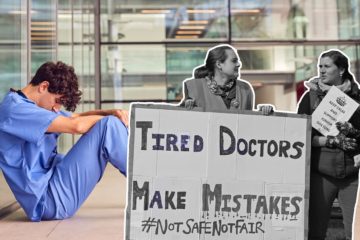by Carol A Westbrook

It was the last straw. “We’re transferring you, Dr. Westbrook,” my Medical Director said to me.
“One of our offices in another town is desperately in need of a Hematologist, ever since Dr. Paul died,” he continued, “and you are the best hematologist on our staff,” he said, trying to cajole me with flattery.
“But I don’t want to be transferred. I really like working here,” I said. “I have a nice practice, which I built up over the last three years since I started here. I really like my patients and have a good rapport with them. Furthermore, I feel I am part of the community now.”
“Don’t worry. We will assign your patients to one of our other doctors, “he said, in a rather cold-blooded tone. It was no consolation at all.
“Do I have a choice? “I asked bluntly.
“No, not if you want to get paid. You can either transfer, or lose your job,” he said. The Director knew that I could be fired without cause, at the discretion of any of my superiors.
I gave it some thought and reviewed my options. The opportunity to practice full-time Hematology was actually appealing; it’s a difficult specialty, and I enjoy the challenge. And there would be no hospital call, either. But on the downside, it would mean a long commute—it’s thirty miles away from home, traveling on a crowded interstate, US81 with a lot of speeding truck traffic and three mountain ranges to cross. Most importantly, I would have to leave a practice that I’d built up over three years, with many dear patients I hated to leave behind. If I refused the transfer, I would lose my job, and I doubted if I would be able to find another position at age 64. It would still be a year until I would qualify for Medicare and for full Social Security benefits. I would have to stick it out.
In addition to the “terminate at will” clause, my contract also contained a “non-compete clause,” which prohibited me from working in a clinical position within fifty miles of one of our numerous clinics or hospitals. Since our health care organization is rapidly expanding throughout all of our state, I would have to travel far from home to find a place that is more than 50 miles away from one of our facilities. I would have an even longer commute than the proposed transfer! (The US Senate is currently considering a bill that would make non-compete clauses illegal, but at the time non-compete clauses were enforceable.)
In reality, I had no choice but to take their offer. But I promised myself that I would retire the following year, when I hit age 65, and I did—but that’s another story.
Every doctor at out institution worked under the same contract conditions. At the time I took the job, the contract was non-negotiable and I really wanted the job. So I signed on, recognizing what a stranglehold that our bosses would have over us.But I also realized that the only way we would have any strength in bargaining with powerful corporate administration was in a group with a large voice, that is to say, with a union.
I tried to get a group of us together in a meeting to hash out our grievances and form a union that would be recognized by the NLRB (National Labor Relations Board), but it seemed that no one had time to meet, or was enthusiastic about the idea. Others had excuses. Some were afraid they would be fired if they tried to unionize (though it was illegal to do so.)

Most felt that being in a union did not fit the image of a doctor; it was too “blue collar.” They were afraid their patients would think that doctors were greedy and wanted a union to bargain for more. And everyone felt that a doctors’ strike would be a disaster! When I couldn’t get a group together, I contacted the AFL-CIO and spoke to an organizer to see if I could get help organizing a union—if any practice needed a union, it was ours—but even there I was met with resistance–the person with whom I spoke said that doctors couldn’t unionize because they were bosses! This incorrect statement threw me off the track for a long time.
But the objective of a doctors’ union was not to negotiate for increased salary, but to improve our own working conditions. We didn’t want to have to squeeze in too many appointments each day; we wanted to devote the time and insight that each patient required, even if it meant seeing fewer patients per hour. This would greatly benefit our patients, who now get a mere 10 or 15 minutes to talk to their doctor, time which every one of my cancer patients valued. Longer contact time would result in less income for the hospital system, and would require hiring more doctors–but would improve the care each patient received. And we couldn’t be arbitrarily transferred against our will in order to solve the administration’s staffing problems. I felt that I was on to something here. Being in a physician’s union would give us more control of our jobs, and let us take better care of our patients without the threat of losing our jobs. We could discard those threatening clauses – fire at will – and non-compete – and feel more secure in our positions.
For many years, doctors worked independently, running their own small practices, always available, or providing coverage, even making house calls as needed. You may remember your own GP’s office like this. But as costs for malpractice insurance, staff salaries, and medication increased, revenue went down. Many small practices became unsustainable and were bought out by large hospital corporations. Over the last decade this buyout increased, particularly during the pandemic. Many physicians gave up the idea of running their own private practices, and took jobs as employees of the hospitals.

Now, as providing medical care transitions from cottage industry to big business, physicians are becoming workers in health care factories. Their jobs are becoming re-engineered so accountants can keep better track of their revenue and expenses, their productivity is scrutinized by foremen, and they are being squeezed to do more with less. Physicians go along with this because their code of ethics requires them to provide care and not leave any patient without coverage, and their employment contracts leave them no recourse. Health care organizations take advantage of this because doctors have no way to look after their own interests. Burnout and stress increase among providers, while the quality of health care goes down. There is no balance in a system like this unless the doctors have a voice.
As of January 1, 2022, nearly three quarters of U.S. physicians (74%) are employed by hospitals, health systems, or corporate entities. Yet only 7.2% were in unions. I wondered, with so many employed physicians, why so few were in unions. I have no answer for this, but feel confident that this percent will increase as doctors learn the value of unionization—it will provide balance to an otherwise lopsided system, and overall improve patient care while decreasing burnout among the doctors.
So I took the position and lasted the year, retiring in May the following year. I did not take another clinical job, but instead I moved back home to live full-time with my husband, where I enjoyed working as a consultant and spending time with the family—especially with the grandchildren.
I am no longer interested in unionization. Last I checked there are no doctors’ unions is the health care system where I previously worked. The nurse practitioners and physician assistants, however, have just voted to join an Association of Staff Nurses and Allied Professionals. It baffles me why doctors in the system who are merely employees haven’t unionized yet. I do hope it happens soon. I believe that unionizing the physicians will transform the organization from one whose main interest is making money into one whose mission is to provide patient-centered health care, a place where doctors love to work.
